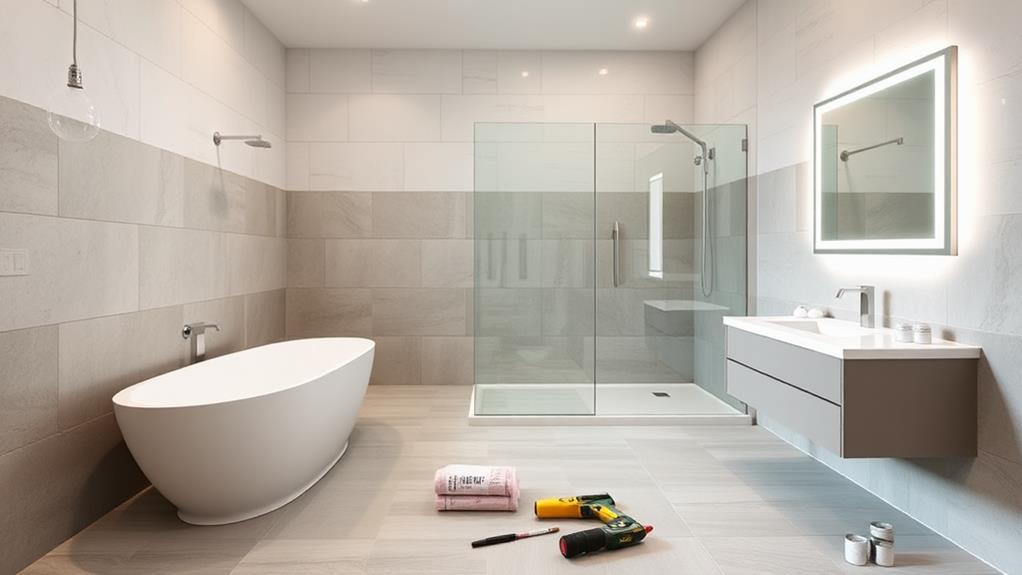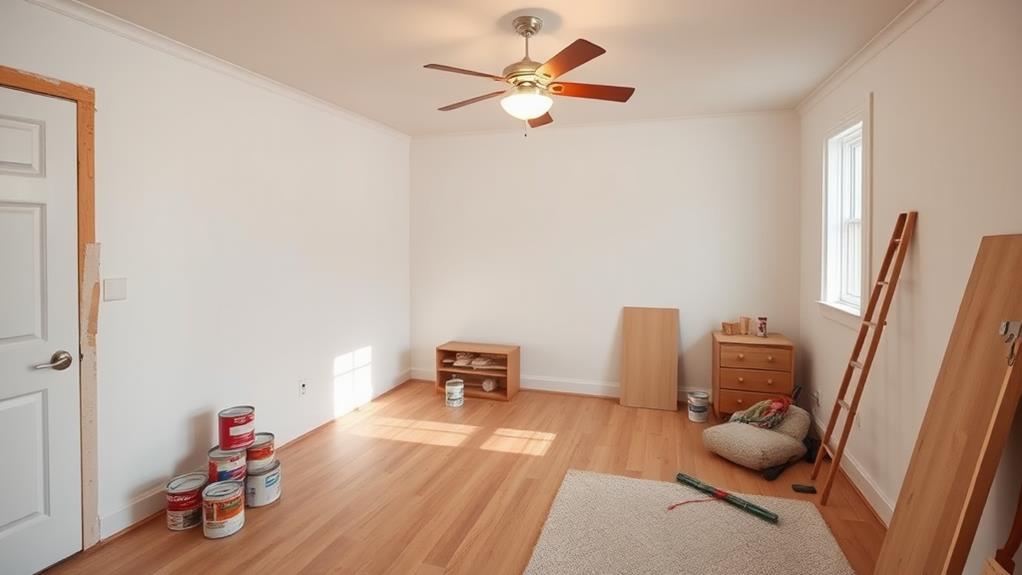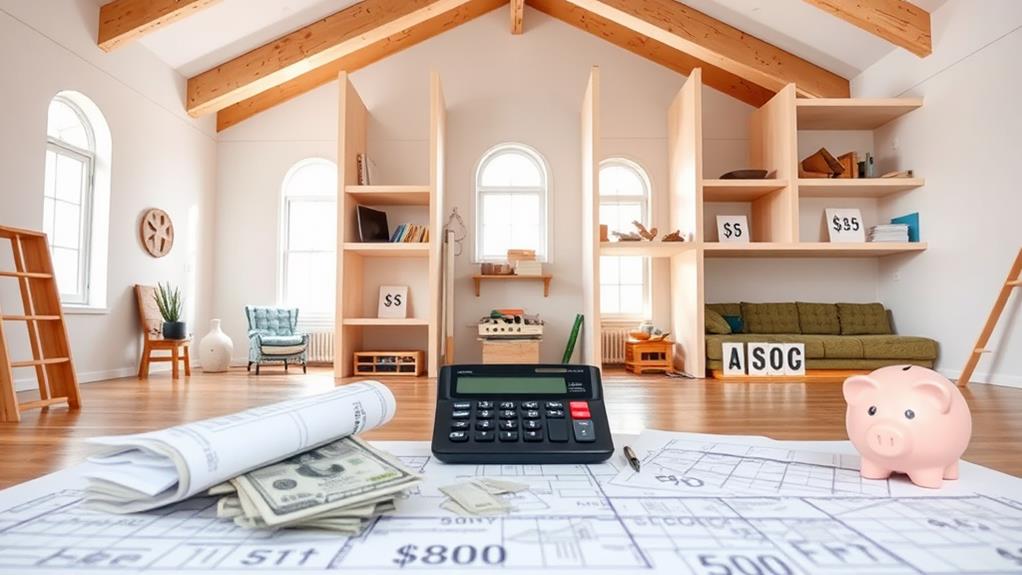
Breaking down your renovation budget by room and priority helps optimize your home improvement plans. Start by assessing your overall budget and financial resources. Allocate funds to high-ROI areas like kitchens and bathrooms, which typically require 20-35% and 40-65% of their budgets for labor, respectively. Living rooms and bedrooms often focus on furniture, flooring, and lighting. Exterior improvements, such as roofing and siding, can significantly boost curb appeal. Prioritize renovations based on necessity, potential return on investment, and available funds. Remember to set aside 10-20% for unexpected expenses. Understanding the breakdown of costs for each room will help you make informed decisions about your renovation project.
Assessing Your Overall Budget

Establishing a comprehensive renovation budget is the crucial first step in any home improvement project. Begin by evaluating your financial resources, including savings, home equity, and potential loans. Consider your long-term goals for the property, whether it's increasing resale value or enhancing personal comfort. Research average costs for similar renovations in your area to set realistic expectations.
Next, prioritize your renovation needs and wants. Create a detailed list of all desired improvements, then rank them by importance. This will help you allocate funds effectively and make informed decisions if budget constraints arise. Don't forget to factor in unexpected expenses by setting aside a contingency fund of 10-20% of your total budget.
Consult with professionals such as contractors, architects, or designers to get accurate cost estimates for specific projects. They can provide valuable insights into potential challenges and help refine your budget. Consider the impact of renovations on your home's overall value and energy efficiency. Lastly, be prepared to make trade-offs and adjustments as you balance your vision with financial realities.
Kitchen Renovation Costs
Kitchen renovations typically account for the largest portion of a home improvement budget, often ranging from 10% to 15% of a property's value. This substantial investment is due to the complexity of the space, which combines functionality, aesthetics, and high-use appliances.
Major cost factors include cabinetry, countertops, and appliances, which can collectively consume up to 70% of the kitchen budget.
Cabinetry costs vary widely, from $2,000 for stock options to $30,000 or more for custom designs. Countertops range from $200 to $250 per square foot for high-end materials like quartz, while budget-friendly laminate can cost as little as $40 per square foot. Appliance packages typically start around $3,000 for basic models and can exceed $20,000 for premium brands.
Other significant expenses include flooring, lighting, and plumbing fixtures. Labor costs, which can account for 20% to 35% of the total budget, depend on the project's complexity and local market rates.
To manage costs effectively, prioritize elements that impact functionality and daily use, consider a mix of high-end and budget-friendly choices, and explore cost-saving alternatives like refacing cabinets instead of full replacement.
Bathroom Upgrades and Expenses

Revitalization of a bathroom can significantly enhance a home's value and functionality. When budgeting for bathroom upgrades, consider both essential improvements and luxury additions.
Essential upgrades include replacing outdated plumbing fixtures, updating electrical systems, and addressing any water damage or mold issues. These basic renovations typically range from $5,000 to $15,000, depending on the bathroom's size and existing conditions.
For a mid-range renovation, expect to spend between $15,000 and $30,000. This budget allows for quality fixtures, new flooring, updated lighting, and possibly a new vanity or shower enclosure.
High-end bathroom remodels can easily exceed $50,000, incorporating premium materials like marble countertops, custom cabinetry, and luxury features such as heated floors or steam showers.
Key cost factors include labor, which often accounts for 40-65% of the total budget, and materials. Relocating plumbing or electrical elements significantly increases expenses.
To maximize your investment, focus on improvements that offer the best return, such as efficient fixtures, modern lighting, and timeless design elements. Consider future needs and accessibility features to ensure long-term value and functionality.
Living Room Makeover Budgeting
Moving from the bathroom to the heart of the home, the living room often requires a carefully planned budget for a successful makeover. Allocating funds effectively can transform this central space into a comfortable and stylish area for relaxation and entertainment.
Begin by assessing the room's primary needs, such as flooring, lighting, and wall treatments. Flooring typically consumes a significant portion of the budget, with options ranging from hardwood to carpet. Allocate 20-30% of your total budget for this element. Lighting can dramatically alter the ambiance, so consider investing 5-10% in a mix of ambient, task, and accent lighting.
Wall treatments, including paint or wallpaper, generally require 5-10% of the budget. For furniture, which often forms the focal point of the living room, set aside 30-40% of your funds. This should cover essential pieces like sofas, chairs, and tables.
Don't forget to budget for window treatments (5-10%) and accessories (5-10%) to complete the look. Lastly, reserve 10-15% for unexpected expenses or splurge items that can elevate the overall design.
Bedroom Transformation Expenses

The bedroom sanctuary often requires a thoughtful approach to budgeting for a successful transformation. When allocating funds for a bedroom renovation, prioritize essential elements that contribute to comfort and functionality. Start with the bed, typically the most significant expense, allocating 30-40% of your budget for a quality mattress and frame.
Flooring is another crucial component, with options ranging from plush carpeting to hardwood, accounting for 15-20% of expenses. Lighting plays a vital role in creating ambiance, so reserve 10-15% for a mix of ambient and task lighting fixtures. Window treatments, essential for privacy and light control, should receive 5-10% of the budget.
Allocate 15-20% for storage solutions, including closet systems or dressers. The remaining 10-15% can cover paint, decor, and accessories to personalize the space. Remember to factor in labor costs if hiring professionals for installation or specialized work. By carefully planning your bedroom renovation budget, you can create a serene retreat that balances comfort, style, and functionality without overspending.
Exterior Improvements and Costs
A home's exterior serves as its first impression and plays a crucial role in curb appeal and overall property value. When budgeting for exterior improvements, prioritize essential repairs and upgrades that protect the structure and enhance aesthetics. Roofing repairs or replacement typically range from $5,000 to $15,000, depending on materials and size. Siding updates can cost between $5,000 and $20,000, with vinyl being a cost-effective option and fiber cement offering durability at a higher price point.
Landscaping improvements vary widely, from basic lawn care ($1,000-$5,000) to elaborate garden designs ($10,000-$50,000+). Consider investing in energy-efficient windows ($300-$1,000 per window) to improve insulation and reduce utility costs. Exterior painting ($3,000-$7,000) can dramatically refresh a home's appearance. For entryway enhancements, budget $500-$2,000 for a new front door and $1,000-$5,000 for a porch makeover. Driveway resurfacing or replacement ranges from $2,000 to $10,000. Remember to allocate funds for outdoor lighting ($500-$3,000) and gutters ($600-$2,400) to protect the foundation and improve functionality. Prioritize projects based on necessity, return on investment, and available budget to maximize the impact of exterior improvements.
Prioritizing Renovations for ROI

When planning home renovations, savvy homeowners should focus on projects that offer the highest return on investment (ROI). Prioritizing renovations based on ROI ensures that your money is well-spent and adds value to your property.
Kitchen and bathroom remodels consistently rank as top ROI projects. Updating these spaces with modern fixtures, energy-efficient appliances, and quality finishes can yield returns of 70-80% of the investment. Next, consider enhancing curb appeal through exterior improvements like replacing siding, updating the front door, or landscaping, which can offer ROIs of 60-100%.
Energy-efficient upgrades, such as installing new windows or adding insulation, not only reduce utility costs but also appeal to environmentally conscious buyers. Finishing a basement or attic can add valuable living space and typically returns 70-75% of the cost.
Lower on the priority list are luxury additions like swimming pools or home theaters, which often have lower ROIs. Instead, focus on necessary repairs and updates that improve functionality and aesthetics. By prioritizing renovations based on ROI, homeowners can make informed decisions that maximize their investment and increase their home's overall value.
Hidden Costs to Consider
While budgeting for home renovations, homeowners often overlook several hidden costs that can significantly impact their overall expenses. These unforeseen costs can quickly derail a renovation project if not accounted for in advance.
Permit fees are a common oversight, varying by location and project scope. Structural issues discovered during demolition, such as water damage or outdated wiring, can lead to unexpected repairs. Temporary housing costs may be necessary for extensive renovations, while storage fees for furniture and belongings should be considered.
Professional services like architects, engineers, or interior designers can add substantial costs. Upgrades to meet current building codes or energy efficiency standards may be required. Debris removal and disposal fees are often underestimated, as are costs for tools and equipment rentals.
Landscaping repairs due to construction damage and post-renovation cleaning services should be factored in. Additionally, homeowners should budget for potential cost overruns and delays, typically 10-20% of the total project cost. By anticipating these hidden expenses, homeowners can create a more accurate and realistic renovation budget, reducing financial stress and ensuring project completion.
Financing Your Home Renovation

Financing a home renovation can be a complex but crucial aspect of the project's success. Homeowners have several options to consider when funding their renovations. Personal savings are often the first choice, offering the advantage of avoiding interest payments. However, for larger projects, many turn to home equity loans or lines of credit, which allow borrowing against the equity in their property.
Another popular option is a cash-out refinance, where homeowners refinance their mortgage for more than they owe and take the difference in cash. For those with good credit, personal loans can provide quick funding without using the home as collateral. Credit cards may be suitable for smaller renovations but typically come with higher interest rates.
Government-backed loans, such as FHA 203(k) loans, are designed specifically for home improvements and can be an excellent option for extensive renovations. Some homeowners also explore contractor financing or specialized renovation loans offered by certain lenders. It's crucial to compare interest rates, terms, and fees across different financing options to find the most cost-effective solution for your specific renovation needs and financial situation.
Frequently Asked Questions
How Long Does a Typical Home Renovation Project Take to Complete?
The duration of a typical home renovation project varies widely depending on its scope. Small-scale renovations may take a few weeks, while comprehensive whole-house remodels can extend to several months or even a year in complex cases.
Should I Hire an Interior Designer for My Renovation Project?
Seeking a polished, cohesive look for your home renovation? Hiring an interior designer can be beneficial, especially for large-scale projects. They bring expertise in space planning, color coordination, and material selection, potentially saving you time and costly mistakes in the long run.
Can I Live in My Home During Major Renovations?
Living in your home during major renovations is possible but challenging. Consider factors like safety, noise, dust, and access to essential facilities. Some homeowners opt for temporary relocation, while others adapt by renovating in phases or creating livable zones.
How Do I Choose the Right Contractors for My Renovation?
To choose the right contractors for your renovation, research thoroughly, obtain multiple bids, check licenses and insurance, review past work and references, and ensure clear communication. Consider expertise, reputation, and compatibility with your project's scope and budget.
What Permits Are Required for Different Types of Home Renovations?
Ah, permits, the bureaucratic circus that turns homeowners into unwitting clowns! Generally, you'll need permits for structural changes, electrical work, plumbing, and additions. Check with your local building department for specific requirements in your area.
Conclusion
In the grand tapestry of home renovation, budget allocation emerges as the critical thread weaving together aspirations and realities. By methodically breaking down costs per room and prioritizing based on return on investment, homeowners can navigate the complex landscape of upgrades. Careful consideration of hidden expenses and financing options further fortifies the renovation strategy. Ultimately, a well-planned budget transforms mere bricks and mortar into a harmonious symphony of form and function, elevating both living spaces and property value.

